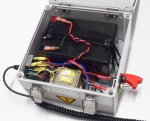Need a cool toy for your kids? How about something with a bunch of fun fluid dynamics and a tinge of higher-than-average-voltage danger? Did we mention the subwoofer and bank of high-voltage capacitors? Have we got the project for you: [Robert Hart]’s vortex cannon design.
We’ve seen vortex cannons before, where you usually fix a balloon to the back of a trash can. Pull on the balloon membrane and then let it go with a snap, and it sends out a swirling donut of high-pressure air that travels surprisingly far. It’s like smoke rings, but amped up a bit.
[Robert]’s addition is to bolt on a high-power subwoofer in place of the balloon’s rubber membrane, and generate the air pulse by dumping a capacitor bank into the speaker.
 The circuit design is a bit more clever than we thought at first. The bottom half is a voltage inverter followed by a diode bridge rectifier that essentially makes 320V DC (peak) out of 12V, and stores this in four fairly large capacitors. A pushbutton activates a relay that dumps the capacitors through the speaker.
The circuit design is a bit more clever than we thought at first. The bottom half is a voltage inverter followed by a diode bridge rectifier that essentially makes 320V DC (peak) out of 12V, and stores this in four fairly large capacitors. A pushbutton activates a relay that dumps the capacitors through the speaker.
On top of the circuit is a -12V voltage inverter. Just before firing, the speaker is pulled back a little bit by applying this -12V to the speaker, and then the relay is triggered and the capacitors dump, shooting the speaker cone forward.
 [Robert] is still developing and testing the device out, so if you’re curious or just want to say hi, head on over to Hackaday.io and do so! Be sure to check out his videos. The smoke tests are starting to look good, and we love the control box and high-voltage warning stickers.
[Robert] is still developing and testing the device out, so if you’re curious or just want to say hi, head on over to Hackaday.io and do so! Be sure to check out his videos. The smoke tests are starting to look good, and we love the control box and high-voltage warning stickers.
















“Bass Canon”
That schematic’s font… what’s a yortex cannon?
Effective against drones?
Wow, that’s actually a good question.
Very cool. What kind of distances are you seeing?
All right you primitive screwheads! Listen up! See this? This – Is my bucket!
Looks like an oversized in-ear earphones to me.
Dare you :)
Finally, the PMPO rating of a speaker actually means something…
As for a smoke source, a miniature smoke machine would work nicely.
I was thinking the voice coil would be a great smoke source…
I laughed.
Very cool. When I was a kid Mattel or someone made the “Sonic Air Blaster”. There was a handheld and a shoulder bazooka style. A big lever cocked the hand held by pulling back a rubber diaphragm. They were not silent, but they didn’t sound like they were going to blow your hat off from 20 feet. Here is Kurt Russel demonstrating https://www.youtube.com/watch?v=El6t8lcz0V4 I can’t find the hand held one. Maybe the rubber diaphragms are all shot.
In the add, Kurt Russel is aiming the “Air blaster” along a busy highway. What would happen to a kid doing that today? Favorite Kurt Russel movie: Escape from New York 1981, (even worse that the Tina Turner Mad Max movie).
I think a IGBT would be better then a relay,
A side effect of using a relay is its delay which in this case is useful: when shoot button is pressed the woofer is supplied with -12V which moves backwards the cone. As soon as the relay closes (which is not instantaneous) the woofer sees the full positive voltage and moves forward. In other words, it “charges itself” with a bit more air just before firing. Brilliant!
use a basketball as a cannon ball. see how painful one can shoot someone.
Just for those of us who miss our wammo air blasters!
“Where there’s smoke there’s fire”, but in this case there’s “fire” but no smoke. An invisible vortex isn’t much fun. What happens if you fire this in a room that’s been filled with fog or smoke? (Especially if you have clear air in the cannon and uncover it just before firing). Do you get an inverse vortex? I’d also like to try firing it into a mist of water coming from a garden hose, especially in bright sunlight. And I’d REALLY like to try firing it at the annoying dogs next door–nonlethal dog repellent! (Hmm… Maybe I’ll fill it with a cloud of chili flakes.) Hang one over my flower bed with a motion sensor and scare away pesky rabbits and squirrels. Endless possibilities for weaponizing!
Would a woofer like this one (http://www.parts-express.com/dayton-audio-dcs305-4-12-classic-subwoofer-4-ohm–295-204) be up to the task? The author doesn’t mention the impedance of the speaker he used, and it seems to me that it would make a difference.
I am scratching my head at this one. Why 320 volts? Seems like the force from that would tear the speaker apart even if it didn’t move much. But how far does the cone even move? If the objective is to snap the cone forward as fast as possible, I have news for you… the size of that bucket would dampen such a rise time. I wonder if the bucket even needs to be that big? Why not just use a 40-60 volt or whatever pulse which lasts a bit longer and reaches the Xmax of the coil?